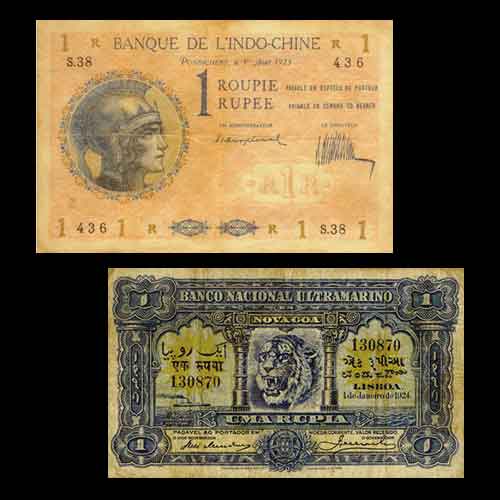One Rupee Notes of Indo-French and Indo-Portuguese
2017-11-25 Sat
The French and Portuguese are among the most influential European powers to establish trade relationships with India. The Portuguese came to India in 1498 and remained a dominant power until two centuries. Their power declined in the 18th century with the rise of British East India Company; their supremacy was now limited to Goa, Daman-Dui and Dadra-Nagar Haveli. The French power came to India with French East India Company and reached its peak in 1750, but due to the conflict with British and French revolution, their colonies were restricted to the coastal regions while their main settlement was Pondicherry.British were not the only foreign power to issue paper money in India. The specimens printed by France and Portugal were quite fascinating, especially the smallest denomination, one rupee. Rupee history is long and can be traced back to ancient India, yet the early modern history illustrates a fascinating tale for this denomination.
These two foreign administrators issued One Rupee notes for their India occupied territories. The above image depicts the Uma rupia or 1 Rupia Nova-Goa note of Portuguese in 1917. It was the second issue of Overseas National Bank of New Goa. The first issue of French was one Roupie in 1924. The French banknote depicted Marianne, the symbol of France since the French revolution. On this note, the given date of circulation was 192 but its actual circulation started in the year 1924.
The second issue of one rupee note of Portuguese circulated in 1924 with a major design change. This denomination now depicted an Indian tiger and Jagannath Temple of Puri.
The circulation of French note stopped in 1954. Later on, Portuguese notes stopped circulating in 1961.
Don't you all agree that that spread and influence of one rupee notes is fascinating? But why is Mintage World posting about Indian one rupee notes all of a sudden? Well, it’s a secret for us to know and you to guess...
Latest News
-
Gold Pagoda of Vijaynagar Empire King Deva Raya I
2024-04-10 WedKing Deva Raya I of the Vijayanagara Empire was a patron of Kannada literature and architecture. He ...
-
Silver Denarius of Septimus Severus
2024-04-05 FriLucius Septimius Severus served as the Roman emperor from 193 to 211 AD. Severus sat on the throne o...
-
Extremely rare 'Malaharamari' type Gold Gadyana of King Guhalladeva-III Sold for INR 611000
2024-04-03 WedTribhuvanamalla, also known as Guhalladeva III, was the ruler of the Kadamba dynasty. His reign coin...
-
90 Years of RBI
2024-04-02 TueOn 1st April, PM #Modi unveiled a special commemorative coin marking 90 Years since the foundation o...
-
Silver Denarius of Julia Mamaea
2024-04-02 TueJulia Avita Mamaea, a Christian Syrian noblewoman, was the mother of Roman Emperor Alexander Severus...

